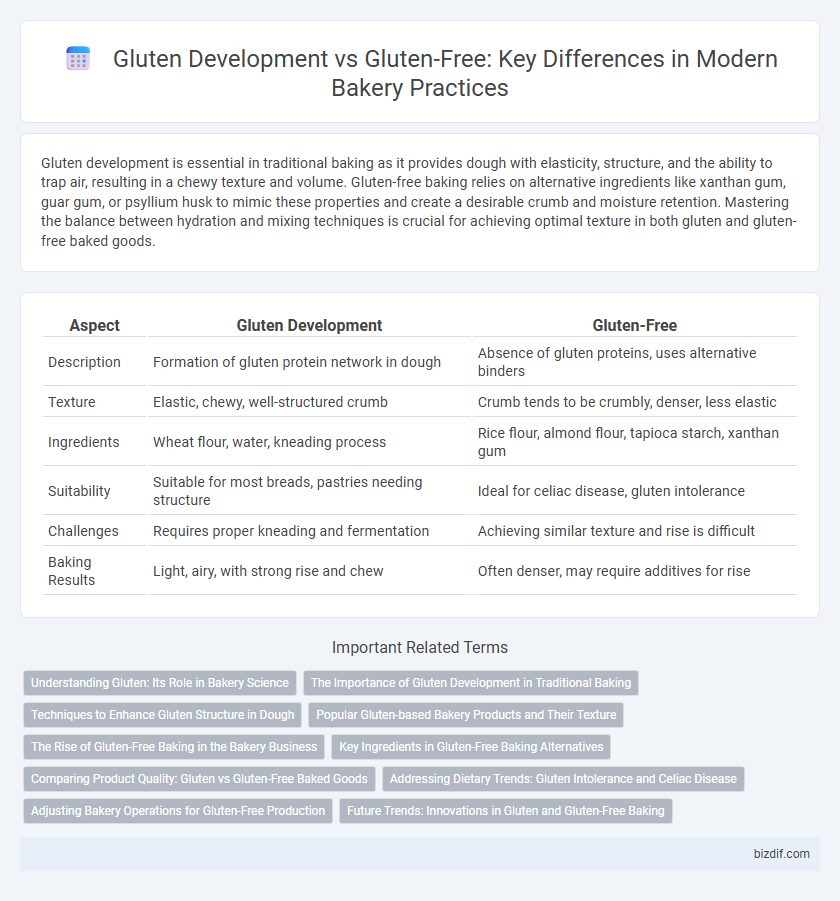Gluten development is essential in traditional baking as it provides dough with elasticity, structure, and the ability to trap air, resulting in a chewy texture and volume. Gluten-free baking relies on alternative ingredients like xanthan gum, guar gum, or psyllium husk to mimic these properties and create a desirable crumb and moisture retention. Mastering the balance between hydration and mixing techniques is crucial for achieving optimal texture in both gluten and gluten-free baked goods.
Table of Comparison
| Aspect | Gluten Development | Gluten-Free |
|---|---|---|
| Description | Formation of gluten protein network in dough | Absence of gluten proteins, uses alternative binders |
| Texture | Elastic, chewy, well-structured crumb | Crumb tends to be crumbly, denser, less elastic |
| Ingredients | Wheat flour, water, kneading process | Rice flour, almond flour, tapioca starch, xanthan gum |
| Suitability | Suitable for most breads, pastries needing structure | Ideal for celiac disease, gluten intolerance |
| Challenges | Requires proper kneading and fermentation | Achieving similar texture and rise is difficult |
| Baking Results | Light, airy, with strong rise and chew | Often denser, may require additives for rise |
Understanding Gluten: Its Role in Bakery Science
Gluten development is crucial in bakery science as it provides dough elasticity and structure, allowing it to trap gases and rise effectively. In contrast, gluten-free baking requires alternative binding agents like xanthan gum or psyllium husk to replicate these properties and maintain texture. Understanding gluten's role helps bakers create products with the desired chewiness, volume, and crumb, whether using traditional wheat flour or gluten-free substitutes.
The Importance of Gluten Development in Traditional Baking
Gluten development is crucial in traditional baking as it provides the dough with elasticity, strength, and the ability to trap gas bubbles, resulting in a light and airy texture in bread. Unlike gluten-free products, which rely on alternative binders and often have a denser crumb, traditional gluten-containing doughs create a chewy and well-structured crumb. Mastering gluten development through kneading and resting directly impacts the rise, texture, and overall quality of baked goods such as artisan breads and rolls.
Techniques to Enhance Gluten Structure in Dough
Techniques to enhance gluten structure in dough include proper hydration, kneading, and fermentation to promote the formation of a strong gluten network, resulting in improved dough elasticity and gas retention. Using high-protein flours like bread flour or vital wheat gluten supplements can significantly increase gluten content, boosting dough strength and volume. In contrast, gluten-free baking relies on alternative binders such as xanthan gum or psyllium husk to mimic gluten's structural properties and maintain dough cohesiveness and rise.
Popular Gluten-based Bakery Products and Their Texture
Gluten development plays a crucial role in popular bakery products like bread, pizza dough, and croissants, providing elasticity and a chewy texture that gluten-free alternatives often struggle to replicate. Traditional wheat-based doughs rely on the gluten network to trap gas bubbles during fermentation, resulting in a light and airy crumb structure that defines the texture of these baked goods. Gluten-free products frequently require alternative binding agents such as xanthan gum or psyllium husk to mimic this structure, often leading to denser and more crumbly textures.
The Rise of Gluten-Free Baking in the Bakery Business
Gluten development plays a crucial role in traditional bakery products, providing elasticity and structure essential for bread and pastries. The rise of gluten-free baking has transformed the bakery business by meeting the growing consumer demand for health-conscious and allergen-free options. Advances in alternative flours like almond, rice, and sorghum have enabled bakers to create high-quality gluten-free products without compromising texture or taste.
Key Ingredients in Gluten-Free Baking Alternatives
Gluten-free baking relies heavily on alternative flours such as rice flour, almond flour, and sorghum flour to provide structure and texture without gluten's elasticity. Key ingredients like xanthan gum or guar gum mimic gluten's binding properties, enhancing dough elasticity and moisture retention. Understanding the roles of starches like tapioca and arrowroot is crucial for achieving desirable crumb and rise in gluten-free baked goods.
Comparing Product Quality: Gluten vs Gluten-Free Baked Goods
Gluten development in traditional baked goods enhances dough elasticity, rise, and crumb structure, resulting in products with superior texture and chewiness. Gluten-free baked goods often require alternative binding agents and hydrocolloids to mimic these properties but may fall short in achieving the same volume and mouthfeel. Comparing product quality, gluten-containing items typically offer better freshness retention and structural integrity, while gluten-free options prioritize allergen safety and inclusivity despite texture compromises.
Addressing Dietary Trends: Gluten Intolerance and Celiac Disease
Gluten development plays a crucial role in traditional bakery products by providing elasticity and structure, essential for bread and pastry texture. In contrast, gluten-free baking addresses dietary trends driven by gluten intolerance and celiac disease, requiring alternative ingredients like rice flour, almond flour, and xanthan gum to mimic gluten's binding properties. Innovations in gluten-free formulations ensure safe, enjoyable options for consumers with dietary restrictions while meeting market demand for allergen-free baked goods.
Adjusting Bakery Operations for Gluten-Free Production
Adjusting bakery operations for gluten-free production requires understanding the absence of gluten's elastic network, which affects dough structure and texture. Gluten-free formulations rely on alternative binders like xanthan gum or guar gum to mimic gluten's functionality, ensuring product rise and moisture retention. Equipment sanitation protocols must be strictly enforced to prevent cross-contamination and maintain product integrity for gluten-sensitive consumers.
Future Trends: Innovations in Gluten and Gluten-Free Baking
Innovations in gluten development emphasize enhancing dough elasticity and texture through advanced enzymatic treatments and wheat protein engineering, targeting superior bread volume and crumb structure. Gluten-free baking sees breakthroughs with alternative proteins, such as pea and chickpea isolates, combined with hydrocolloids to replicate gluten's binding properties, delivering improved mouthfeel and shelf life. Future trends focus on sustainable ingredient sourcing and personalized nutrition, leveraging biotechnology to create tailored gluten and gluten-free products that meet diverse dietary needs and environmental goals.
Gluten development vs Gluten-free Infographic

 bizdif.com
bizdif.com